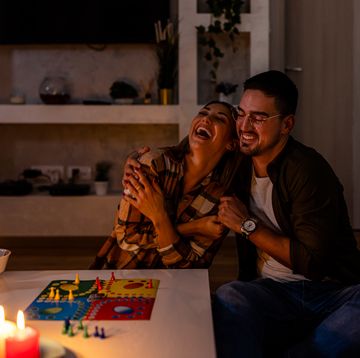In the 21st century, monogamy isn’t necessarily the norm anymore. While open relationships, swinging, and polyamory were once considered somewhat taboo topics, that’s a thing of the past. Today, it's not at all uncommon to see people enjoy different types of non-monogamous relationships. (See: celebs like Willow Smith, Bella Thorne, Kehlani, and Shailene Woodley.)
Now, you may be wondering… what’s the difference between polyamory, polygamy, and an open relationship? For starters, in polyamory, "all members of the relationship or relationships have the consent of their partners to engage with others, though they may choose to remain in only one relationship,” say Tamara Pincus, LCSW, certified sex therapist specializing in polyamorous and LGBTQIA+ clients and co-author of It's Called Polyamory: Coming Out About Your Non-Monogamous Relationships, and Rebecca Rose Vassy, sex, relationship, and body image educator. (BTW, you can still be polyamorous even if and when you’re not currently dating anyone!)
Meet the Experts:
Tamara Pincus, LCSW, is a certified sex therapist specializing in polyamorous and LGBTQIA+ clients and co-author of It's Called Polyamory: Coming Out About Your Non-Monogamous Relationships.
Rebecca Rose Vassy is a sex, relationship, and body image educator at the Pincus Center.
Matt Lundquist, LCSW, is a relationship therapist in New York.
Gin Love Thomson, PhD, is a relationship expert and self-help memoirist.
Polygamy, on the other hand, is a marriage between more than two people. It's “usually related to religion and is a male-dominated concept of the man having several wives,” says says Gin Love Thomson, PhD, a relationship expert and self-help memoirist. “Polyamory, on the other hand, is not gender-exclusive.” In the United States, the practice of multiple-wife polygamy is strongly associated with religions like Mormonism, Pincus and Vassy add. Currently, the practice is also illegal in the U.S.: the act of marrying multiple people at once is criminalized in every state, although people are legally allowed to have and even live with more than one non-marital partner.
Meanwhile, open relationships happen when members of a couple agree to have other, external relationships, which can look different depending on the situation. Sometimes, a couple may decide that each party can date other people, or they might just agree to have casual sex with others outside of their relationship. So, polyamory does fall under the open relationship umbrella, but the more technical term is ethical or consensual non-monogamy.
If you're not super familiar with polyamory, though, you probably still have a few burning Qs. Ahead, relationship experts explain all you need to know about polyamorous relationships.
What is polyamory, and how do polyamorous relationships work?
At the most basic level, polyamorous relationships are intimate relationships that involve more than two people, says Matt Lundquist, LCSW, a relationship therapist in New York.
But polyamory can look like many things in practice. “A polyamorous relationship might include three or more relatively equal partners in an ongoing romantic emotional relationship either sharing a home or dating," he explains. "Or there are also relationships where one or both partners have a more casual relationship ‘on the side.’”
In healthy situations, anyway, this kind of relationship requires a lot of negotiation and communication to prevent anyone getting hurt. “Thoughtful polyamorous relationships often come with rules and agreements ironed out early on,” Lundquist explains.
In fact, in a hierarchical polyamorous relationship, someone can claim one or more of their partners as a "primary," meaning they're more important than the others, explain Pincus and Vassy. The "secondary" would be—you guessed it—a partner whose needs come after the primary. These terms are often used by originally-monogamous couples who are interested in exploring polyamory, but want to protect their situation a bit more, whether they have a home or children together, or share bank accounts. Examples of what this might look like is someone only living with their primary partner, or the primary partner getting to "veto" any partners their spouse has, the experts say.
"Many in the polyamorous community find this idea to be problematic in that they don't want a relationship structure to dictate whose needs are met and how, so many people identify as non-hierarchical and polyamorous," Pincus and Vassy explain. That said, some poly people do have hierarchical relationships. It varies!
What the different types of polyamorous relationships?
In practice, polyamorous relationships can take many different forms. Here are just a few of the terms to know:
- Triad: A triad consists of three people in a relationship together, also known as a "throuple," according to Pincus.
- Quad: A quad is four people in a relationship together.
- Moresome: A moresome is five or more people in a relationship together.
- Polycule: A polycule is a "network of people in relationships with each other," says Pincus.
- Nesting partner: The partner with whom you live and share household responsibilities.
- Kitchen table polyamory: Kitchen table polyamory is a network of polyamorous people who want all members of the party to be very close socially, like sitting around the kitchen table eating together. It can be fun as a chosen family sitch, but some believe it's too limiting for polycule time.
- Parallel polyamory: Parallel polyamory is when one has multiple partners who don't really interact with each other, or are interested in meeting at all (i.e., the opposite of the Kitchen Table, says Pincus).
- Solo polyamory: Solo polyamory is when someone wants multiple partners but isn't interesting in having a primary one.
- Polyfidelity: Polyfidelity is a relationship where three or more people are committed to each other and don't see people outside of their group. Not everyone involved has to be partners with each other, but sometimes they are, says Pincus.
- Relationship anarchy: Relationship anarchy is a relationship style where the relationships aren't titled, but instead can change any time.
Thinking about taking the polyamory plunge? Consider these questions first:
Every solid polyamorous relationship starts with taking a good, hard look at what you want and what’s going to make you happy. To help you decide if a polyamorous relationship is right for you and your partner, start by asking these six questions:
1. How jealous are you?
Can you really handle seeing your partner date other people? “This is the most obvious question, but also the most important and the hardest to answer,” says Lundquist. “Even when a given partner doesn't want to be jealous or possessive, monogamy is so heavily ingrained in our culture, some people just can't get there."
To a certain degree, it’s hard to know how you’ll really feel about your partner having another relationship until you dip your toe in the water, Lundquist says. But taking an honest look at how you’ve dealt with jealousy-inducing situations in the past can give you some important insight, he says.
There are a few specific questions you can ask yourself to test this: How did it feel that time you ran into your partner’s ex at a party? Do you find yourself getting uncomfortable when your partner keeps bringing up how much fun they have with their favorite coworker? Do you feel irritated when you see the bartender flirting with your partner? “I think life tests our jealousy plenty,” Lundquist says. “We just don't always look at the evidence honestly.”
2. Is this something you both want?
“Often, one partner is more into the idea of experimenting with the polyamorous lifestyle than the other,” explains Thompson. If that’s the case, it can cause a problematic power imbalance.
“The slightly hesitant partner, who is often participating to satisfy their partner and keep from losing them altogether, suffers,” she says. “As does the relationship.” If you’re looking to polyamory as a last resort or as a way to keep your partner from cheating, these are major red flags.
3. What is your (and your partner's) motivation?
There are a few common goals that signal the arrangement might be a positive experience for you and your partner.
A major one: feeling limited by monogamy, says Lundquist. If you and your partner both feel that your monogamous relationship isn’t quite meeting your needs for closeness and intimacy (and that no monogamous relationship really could), it might be a signal that polyamory is a better fit for you.
A good motivation might also be as simple as “wanting more love and intimacy in your life, and wanting to see your partner be happy,” Lundquist says.
4. How secure do you feel in your current relationship?
“Sharing a partner creates shifts in the dynamic of trust and intimacy,” says Thompson.
That can be a slippery slope—especially if your relationship isn’t that solid to begin with. “Thoughtful polyamory takes more maturity and a stronger relationship from the start because the issues of jealousy and trust can be so difficult to navigate,” Lundquist says.
Figuring out how secure your relationship is isn’t an exact science, says Lundquist, but there are a few questions you should ask yourself before you test it. Are you and your partner good at resolving fights? Can you easily get on the same page about issues and goals for the relationship? Do you feel secure and not anxious about your partner’s love and commitment?
“It's about looking at the evidence with sober eyes,” says Lundquist, adding it can also be helpful to talk these questions through with a therapist since someone outside the relationship may be able to spot potential issues more easily .
If the answer to a lot of these questions is no, it might mean your relationship is lacking the foundation necessary for polyamory.
5. What ground rules do you want to establish?
As Lundquist points out, polyamorous relationships require a lot more negotiating, so you should be prepared to talk out new challenges as they come up. “Once things get going, you might find yourself surprised that you aren’t always on the same page with your partner,” he says.
The best way to stave off these potential conflicts is to set up some guidelines with your partner from the get-go. Before starting any new relationships, talk through the logistics: What behaviors are okay? Is anyone off limits? Will you spend time together as a group and meet your partner’s partners?
“Even for couples who've bought into the idea of a polyamorous relationship, being able to say, for example, ‘I'd like to skip lunch with your sister so I can go on a date’ can be pretty awkward—not to mention disappointing,” Lundquist says. Before going poly, make a specific list with your partner of which behaviors are okay and which ones aren’t—including how many details you’ll give each other about other relationships or dates.
6. How will trying polyamory affect your future together?
Is polyamory going to be a forever thing? “Discuss with your partner whether you intend to shift gears when you have a kid or at another life event in the future,” says Lundquist.
It’s also a good idea to talk about how you’ll handle it if polyamory no longer feels like it’s working for one of you. “Check-ins are an important part of this type of relationship,” says Lundquist. “Some couples use a therapist for this or even a friend who's more experienced with poly relationships.” Put a standing date on the calendar (these can be as often as bi-weekly or more spaced out every month or so—whatever you feel most comfortable with) where you both know the explicit purpose is to talk about how the relationship is going, which can help remove any awkwardness around bringing it up.
The most important thing, he says, is that each of you feels comfortable expressing when you’re not cool with something. If you don’t feel like you can bring it up when something's not working for you in the relationship, that problem is only going to get bigger the deeper you get into polyamory.
There’s no exact science to answering these questions, but if exploring them makes you or your partner uncomfortable in any way, polyamory may not be the right fit for your current relationship—or you.
Macaela MacKenzie is a journalist who writes about women and power. She covers women’s equality through the lenses of sports, wellness, and the gender gap across industries and is the author of MONEY, POWER, RESPECT: How Women in Sports Are Shaping the Future of Feminism. Mac was most recently a Senior Editor at Glamour where she directed all health and wellness coverage. Her work has appeared in Elle, Glamour, SELF, Bustle, Marie Claire, Allure, Women's Health, and Forbes among other publications.
Addison Aloian (she/her) is the assistant love & life editor at Women’s Health. Outside of topics related to lifestyle, relationships, and dating, she also loves covering fitness and style. In her free time, she enjoys lifting weights at the gym, reading mystery and romance novels, watching (and critiquing!) the latest movies that have garnered Oscars buzz, and wandering around the West Village in New York City. In addition to Women's Health, her work has also appeared in Allure, StyleCaster, L'Officiel USA, V Magazine, VMAN, and more.













